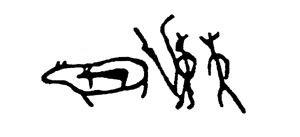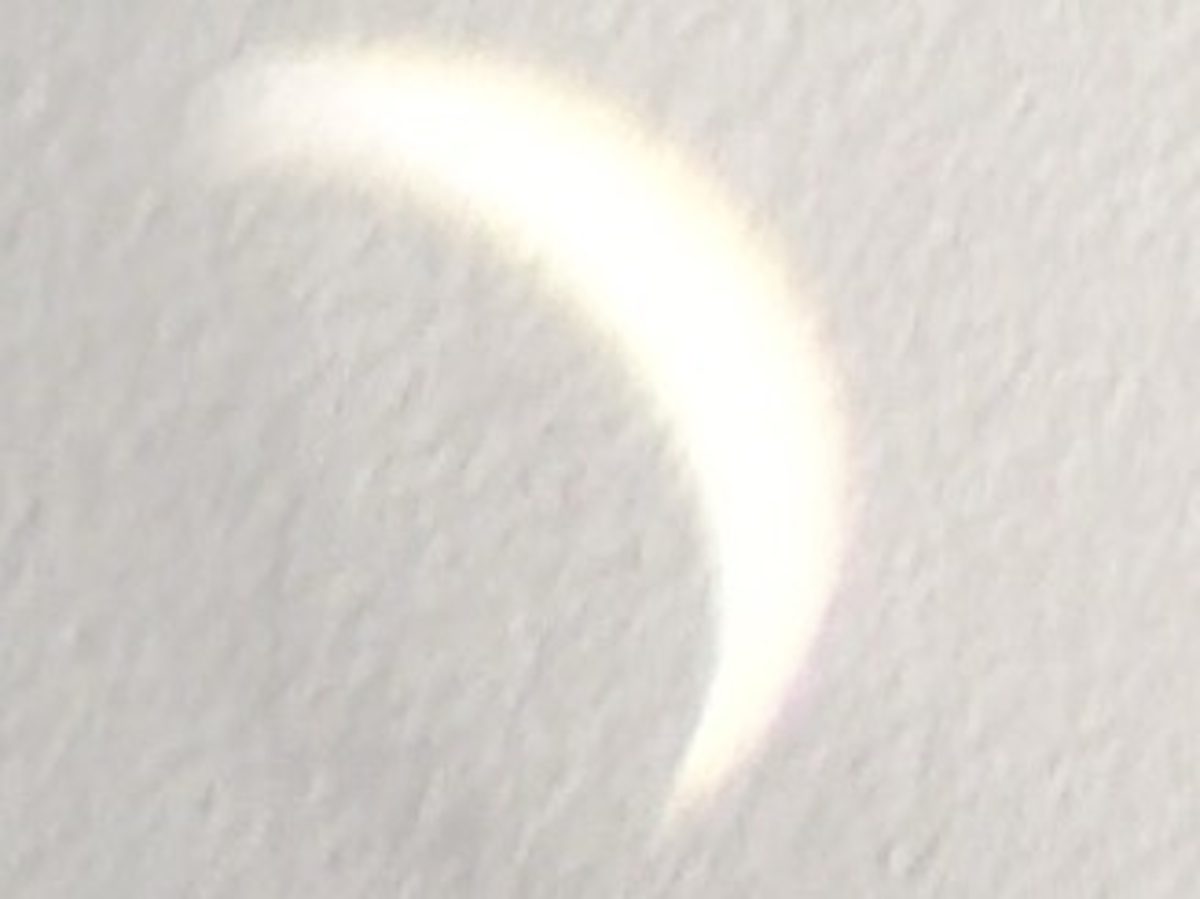
Pete gets photo of 20 March 2015 eclipse, as reflected indoors.
Early December 2013.
Collecting Rose from school and we were able to see comet ISON on its way towards the sun. The sun was setting and comet ISON looked white short and fat with two tails. It was the two tails and position that identified it. We did not have telescope or anything and it was too near the sun's glow for that anyway. Lucky we did see it then, as it had been said that it would be spectacular later, but it broke up instead. Hale Bopp still the best comet seen.
November 2013. Rose helped us with the group visits at the observatory, this autumn.
2012
Helped along with Rose at the open evening. Rose is interested as went along with us to planetarium show at Priory school - that is now the school she wanted to go to.We were helping out winter 2010-2011 with visitors at local observatory. Merv was in charge of installing projector, and also the telescope in the dome, while I help out with the visitors. We had a Jupiter watch, and then the BBC Stargazing event - which bought a lot more interest and new members and visitors. We also helped with visiting groups.
Monday and Tuesday 15th and 16th March, 2010.
we were helping out for visitors to the Lincoln Astronomical Society little observatory. Merv manned telescope and we were able show Mars, Venus, M.42. It was clear enough so they put out 2 more telescopes for the visitors to get a chance to see things. On the 16th March we had more visitors and more helpers, including Rose, who has been very helpful with visitors in the past and sold some postcards and other things. I had printed out some leaflets for free as well. But this time only Mars could be seen, even though Merv had cleaned up the eyepieces for the big telescope. However I also got a chance to see Mars through one of the refurbished eyepieces.
20th August 2009
22.20-22.45: Not such a good view of Jupiter, as low of course and quite a glow around the horizon. Which is why we cannot get to see many southern stars etc. at this latitude - 53 degrees north. Saw a big meteorite streak from zenith to south-east. Then we looked at Jupiter. Merv saw Io edge across Jupiter. When you see how much the 4 largest moons of Jupiter change their position as you watch you can see how easy it was for Galileo to make his observations night after night when he could see Jupiter with its moons in different places as they orbited. He could see that the movements could be used for timing, and used for finding longitude. Not long after, Römer used the timing of the satellites also to calculate the speed of light.I could see the three main northern constellations: Cassiopaeia, Cygnus, Ursa Major, which were so important for early humans in the north, for time-keeping, calendar and in their mythology.
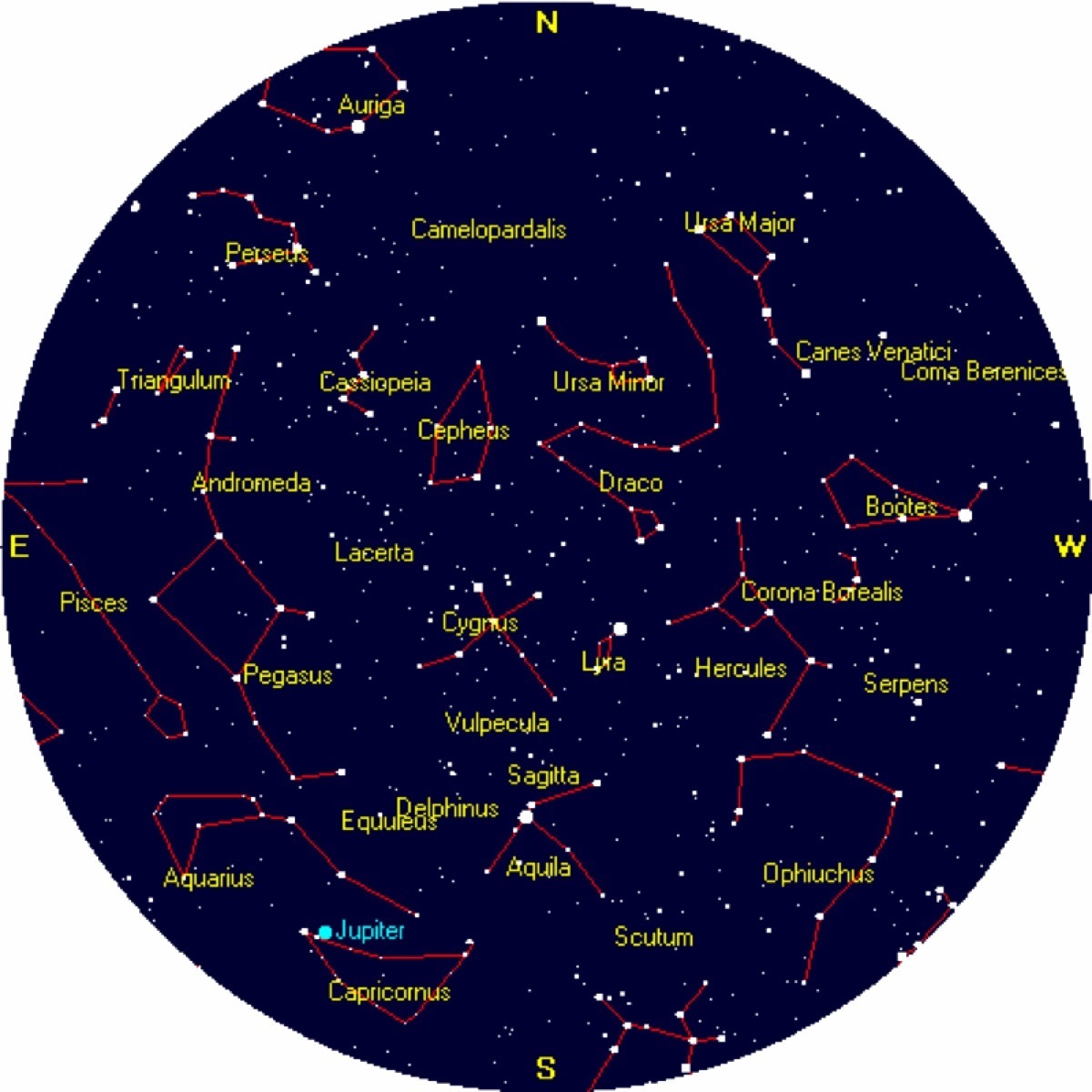
18th August 2009: 21.45, Jupiter and four moons
with our £50 telescope from Lidl.
 Could just see two cloud bands across Jupiter. As in the "sky & telescope diagram. The four moons were all lined up on the right-hand side. Io, Europa, Ganymede, appeared evenly spaced then Callisto seemed nearer to Ganymede from this view point so it had moved round a bit further compared to Io, Europa, and Ganymede which move in resonance with each other. The diagram comes from the useful Sky and Telescope gizmo.
Could just see two cloud bands across Jupiter. As in the "sky & telescope diagram. The four moons were all lined up on the right-hand side. Io, Europa, Ganymede, appeared evenly spaced then Callisto seemed nearer to Ganymede from this view point so it had moved round a bit further compared to Io, Europa, and Ganymede which move in resonance with each other. The diagram comes from the useful Sky and Telescope gizmo.
This was much the same view as Galileo could see 400 years ago, but it then changed the view of the universe as it showed not everything orbited the Earth. The Vatican did not admit Galileo had been right until November 1982.
17th August 2009: 22.30:
See clear sky and stars when putting out last lot of rubbish into black wheelie bin ready for collection, so go round back, switch off lights and out to see the sky. Facing South with Cassiopeia and Perseus to left side. Jupiter to south, and satellite crossing zenith from south-west to north-west (right to left). Also meteorite in south streaking from zenith down. As do not have facilities to take picture show star map. However our view was the reverse since we were looking south, and Cassiopeia was therefore on the left. Ursa Major was almost overhead behind, Cygnus overhead in front.
Jupiter was in opposition to the Sun on 15th August so this happened to be a good time to see it. It appeared in the southern sky very bright, could see it as a disc.
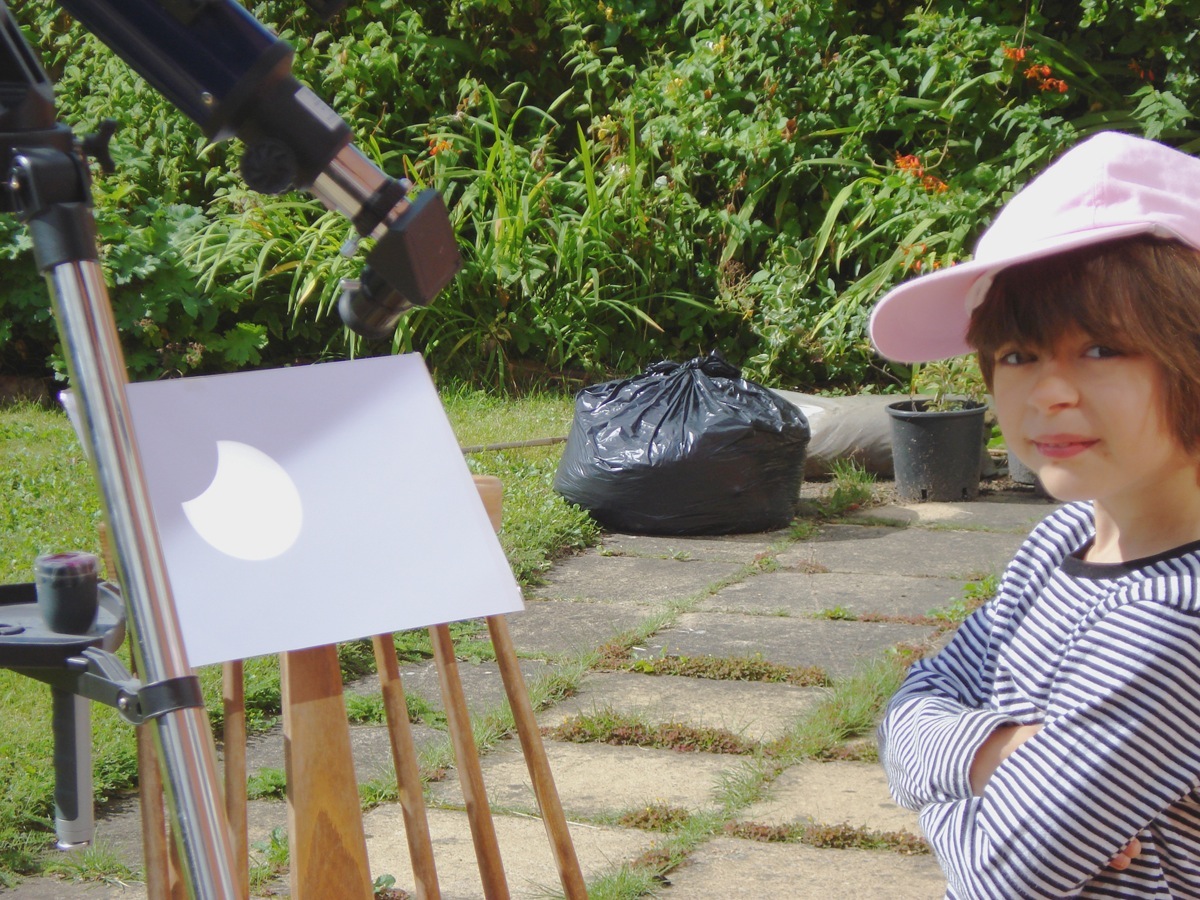
Eclipse of sun, 1st August, 2008
South of the line of totality in Lincoln so it was a partial eclipse beginning at 9.30 - getting as far as it can by about 10.15. Got Sue to bring Rose round to see it as it is educational. Sent a picture to the Echo who published it. Phil Norton also sent a picture but they used mine as they prefered one which used a 50 pound telescope from Lidl in the back garden as it shows it is possible for anyone to see some interesting stuff in the universe from their back garden.
| Saw the southern cross at last 30th April 2008 (just before 65th Birthday). |
|---|
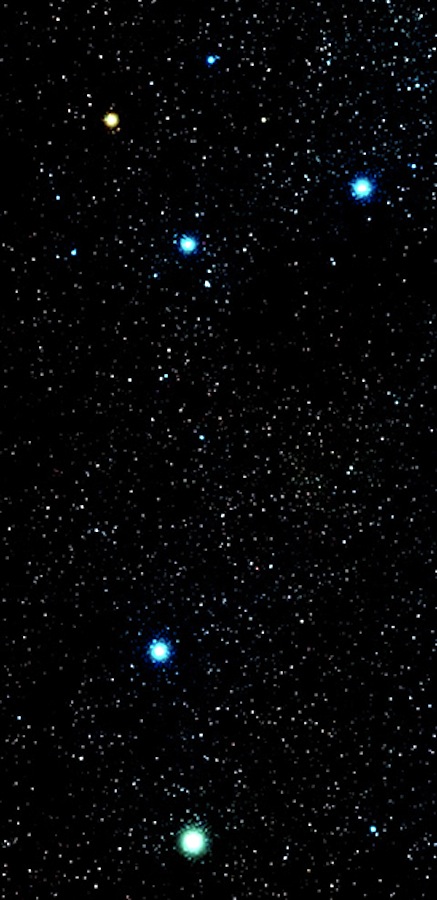 |
| When you founded a new colony, first on the list of things to build was an observatory - you needed to know where it was - the latitude and longitude, so ships could find it. So I knew there must be old observatories in Sydney and Wellington - and there is. |
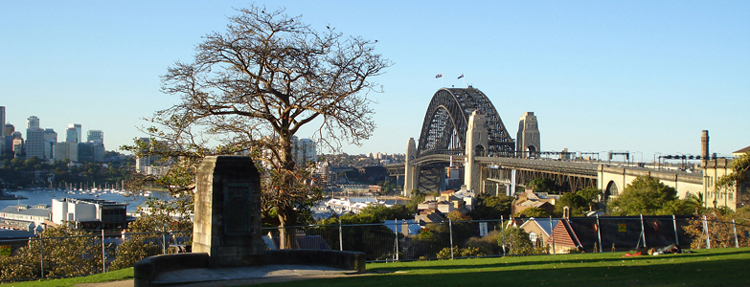 |
| First full day in Sydney, met my aunt Sheila, and as it was clear sky - was not going to waste chance to see the sky. Sheila took us to the historic observatory in Sydney. We stayed until the evening. Scenic view of harbour and iconic Sydney harbour bridge - we had time to climb up a pylon while we waited for night to fall. |
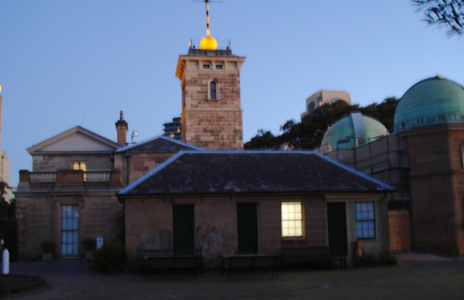 |
| Sydney Observatory in evening, picture by Heather Hobden, shows the time-ball which could be seen by the ships in the harbour. |
| One of the astronomers pointed out the southern cross to us. Although I had timed the trip when it was likely to be visible, had not expected it to be so high in the sky, so big, and visible in the sky over a city the size of Sydney. Big fruit bats flying past. We had tour earlier, showing the telescopes, and also a show about the local traditional cosmology, then in the evening, we had a 3-D show with the special gogs, and then up to the telescope. Were shown many clusters as well and other things could not see from northern hemisphere. Mars and Saturn were also shown. Saturn was still in Leo - and as I had seen this from my back garden - I noticed that Leo did not look like Leo. From Sydney it looks upside down to what it looks like from Lincoln. |
| I feel so lucky that I had this clear sky - as it was the only time on the trip. |
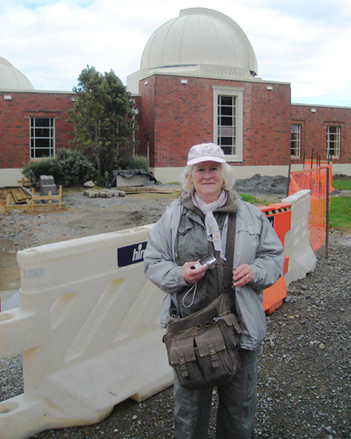 |
| In Wellington, not only was it cold and wet, and shaky with earthquakes, but the National Observatory was shut. It had been closed to the public for more than a year - for "refurbishment" but just before xmas, the astronomers at the Carter observatory were made redundant. |
| The rest of the site was still in use, but not generally open to the public. |
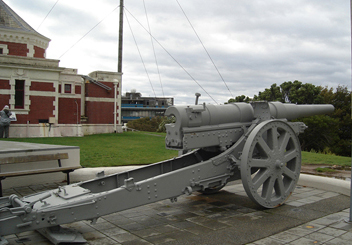 |
| There is the Dominion Observatory, which is also used for monitoring earthquakes, and the meteorology site with a large gun. |
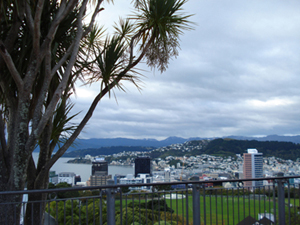
|
| The observatory site is reached by the historic cable car from Lambton Quay, and in the botanical gardens - so you get 3 attractions together and a great view. |
| Back down to Lambton Quay and on to the harbour, the Te Papa museum has lots on Maori cosmology and time keeping and other traditions, as well as the geology and how New Zealand kept its cargo of Jurassic plants and creatures. |
Total eclipse of Moon 3rd March 2007 and Saturn
Was looking after grand-daughter this evening so was able to show her the first part of the eclipse - we went out to back garden to see Moon eclipsed. After she was collected, viewed moon until it was totally eclipsed - did not look as red as it has done in previous eclipses that have seen, it kept a bit of a glow at the top. Meanwhile Merv took out my new telescope which he got for 50 pound in Lidl after I complained about his huge collection of microscopes but no telescope for me. He looked for M42 as usual, but then mistook Sirius for a planet despite my pointing out a real planet by the question mark of Leo - towards Cancer (invisible) and Gemini. Looked this up to convince Merv on my Heavens Above link, which confirmed it was Saturn. Merv set up telescope towards Saturn and it was brilliant. Could see it tilted slightly back and could clearly see the rings. You get great pictures - see my Saturn website for links, from Cassini, but nothing can beat being able to see into space and such an amazing planet from your own back garden. And it really makes your worries feel smaller looking out to the immensity of the universe and seeing such a view from your ordinary suburban back garden with a telescope from the supermarket.
Comet Machholz (C/2004 Q2)8-9 January 2005
Was discovered by Donald E. Machholz of Colfax, California. Said to be green and told it was in Pleiades on January 7 - 2005 - Merv's 60th birthday - impossible to see stars then - not until late on Saturday 8th Janary - when sky clear and wind died down - easier to see with binoculars (the old USSR ones) - it was further north than the Pleiades and you could see the two tails. With telescope looked at M42. The sky was interesting because you could see the Plough standing on its tail in the east and Orion in the west - you don't often get to see the two of them.
Perseids - 12th/13th August 2004
Stormy weather. At midnight 12th - 13th August saw sky cleared so went and looked north-east. Saw bright meteorite streak across north sky from north-east to north-west - in right direction so we did get to see one Perseid. About 00.02. No point in watching for more as sky grew misty and cloudy again. Time to get ready for bed.
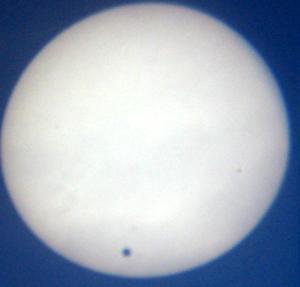
Transit of Venus - 8th June 2004
Here is my picture of it - taken about 7.30.
- See more about Venus and the importance of its transits.
- More on the transit.
- Links to more information on the transit of Venus.
- Society for Popular Astronomy
Eclipse of Moon, Tuesday 4th May 2004
Kathleen phoned me up to see if I had seen it. The Moon was supposed to be in the south-east. Just then we both were able to see it. It was in the south-east but rather low and lurking behind a low belt of cloud. It had only just got dark enough as well, and on the other side of the sky Venus could be seen very bright. It was 21.30 and half-way through totallity. We could see a bright orange rim, dark centre. A little later, when the sky was darker, the clouds in that part of the sky looked red.
Mars - near midnight, 29th August 2003
The skies cleared and revealed Mars in the south. It was so obvious a bright orange light - it spooked anyone who did not know what it was. And it seemed to follow where you went - an eerie feeling last experienced with the Hale-Bopp Comet Spring 1997.
Mars was high enough in the south sky to be viewed with our little telescopes. However the image was not clear enough to be worth photographing. We could just about see the central v-shaped dark markings and south polar cap - features recorded in the 17th century.
Mars was so obvious that anyone could notice it, and find it striking, even those who knew nothing of astronomy.
Mars - near midnight, 3rd August 2003
Mars is closest to the Earth for about 55,000 years so it is a splendid site for those who live further south than us. At our latitude it is still light in the north at night. Mars is in the south of course but so low down the seeing is very bad. Especially with the hot sticky weather we have been having.
We did have the opportunity to view Mars at nearly midnight on 3rd August 2003. It is a spectacular bright orange-red like a ruby in the sky and must have been an awesome sight to our mammoth-hunter ancestors. Being so low it was too wobbly to see much detail through the telescope and to take photos - but at least we did get the chance to see it. Before it rained again.
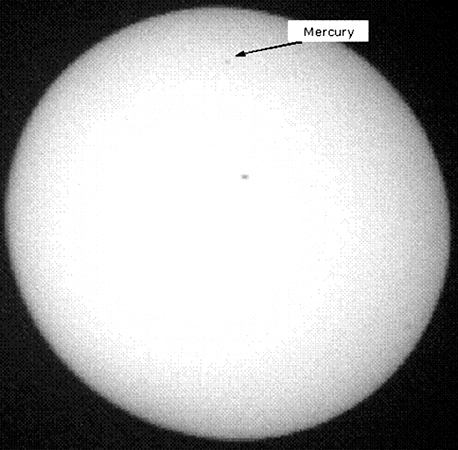
Transit of Mercury - Wednesday morning 7th May 2003
It was cloudy at first and we thought we would only see it on the ESO webcam but then it cleared just as things were under way. We were in email contact with the Echo but by the time their photographer could come it was over. Seeing the transit of Mercury was a chance of a lifetime - and from our own back garden. This image was taken from a back projection.
